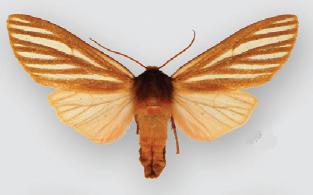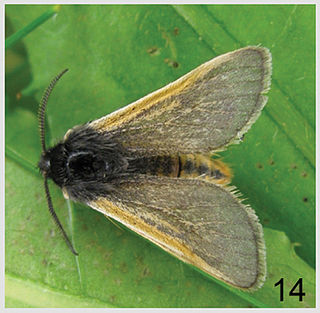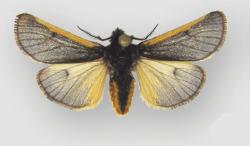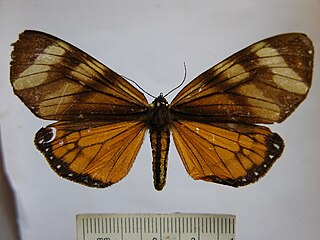
New World orioles are a group of birds in the genus Icterus of the blackbird family. Unrelated to Old World orioles of the family Oriolidae, they are strikingly similar in size, diet, behavior, and strongly contrasting plumage. As a result, the two have been given the same vernacular name.

The Arctiinae are a large and diverse subfamily of moths with around 11,000 species found all over the world, including 6,000 neotropical species. This subfamily includes the groups commonly known as tiger moths, which usually have bright colours, footmen, which are usually much drabber, lichen moths, and wasp moths. Many species have "hairy" caterpillars that are popularly known as woolly bears or woolly worms. The scientific name Arctiinae refers to this hairiness. Some species within the Arctiinae have the word "tussock"' in their common names because they have been misidentified as members of the Lymantriinae subfamily based on the characteristics of the larvae.

The Arctiini are a tribe of tiger moths in the family Erebidae.

The Phaegopterina are a subtribe of tiger moths in the tribe Arctiini, which is part of the family Erebidae. The subtribe was described by William Forsell Kirby in 1892. 469 species of Phaegopterina are present and 52 that are recently discovered in Brazil.
Microryzomys is a genus of rodent in the tribe Oryzomyini of family Cricetidae. It is closely related to Oreoryzomys, Oligoryzomys, and Neacomys. It contains two species, both restricted to the Andes: M. altissimus and M. minutus.

Aemilia is a genus of tiger moths in the family Erebidae described by William Forsell Kirby in 1892. It was initially named Ameles, but this name properly refers to a praying mantis genus.
Tigridania is a genus of moths in the subfamily Arctiinae. It contains the single species Tigridania quadricincta, which is found in Peru.

Pseudohemihyalea ambigua, the red-banded aemilia, is a moth of the family Erebidae. It is found from southern Wyoming to Durango, Mexico.

Pseudohemihyalea syracosia is a moth of the family Erebidae first described by Herbert Druce in 1889. It was formerly believed to be a synonym of Pseudohemihyalea ambigua. It is found from Michoacán, Mexico to Honduras.

Pseudohemihyalea sonorosa is a moth of the family Erebidae. It is found in Sonora, Mexico in the upper elevation pine-oak forests of the Sierra Madre Occidental.

The Euliini are a tribe of tortrix moths.

Andesobia is a genus of moths in the subfamily Arctiinae.

Patagobia is a monotypic moth genus in the subfamily Arctiinae erected by B. Christian Schmidt and Josef J. de Freina in 2011. Its only species, Patagobia thursbyi, was first described by Rothschild in 1910. It is found in Chile and Argentina where it is known from temperate montane woodlands and grasslands in Patagonia.

Andesobia jelskii is a species of moth of the subfamily Arctiinae first described by Charles Oberthür in 1881. It is found in the Department of Junín in Peru.

Andesobia sanguinea is a species of moth of the subfamily Arctiinae first described by George Hampson in 1907. It is found in the Lake Titicaca region of Peru and Bolivia.
Andesobia flavata is a species of moth of the subfamily Arctiinae. It is found in Peru. Only very few specimens are known, and it is closely related to or conspecific with Andesobia boliviana. Externally, the holotype of A. flavata differs from A. boliviana only in having a slightly broader and more diffuse forewing marginal band, suggestive of minor intraspecific variation. However, the genitalic structure of the holotype reveals slight differences compared to A. flavata. Additional study material is needed to properly evaluate the status of these two taxa.
Lachana alpherakii is a species of moth of the subfamily Lymantriinae first described by Grigory Grum-Grshimailo in 1891. It is found in the high mountains of Tibet and China.
Chlorhoda albolimbata, the flashing footman, is a moth of the subfamily Arctiinae. The species was first described by Hervé de Toulgoët and David T. Goodger in 1985 and it is found in Peru.

Dysschema eurocilia is a moth of the family Erebidae first described by Pieter Cramer in 1777. It is a common species throughout tropical America, where it has been recorded from the Antilles, Central America and South America.

Omethidae is a family of Elateroidea sometimes known as the false soldier beetles. They are native to South, Southeast and Eastern Asia and the Americas. Their biology is obscure and their larvae are unknown. They appear to inhabit vegetation in or surrounding forests, and are probably active during the day.










